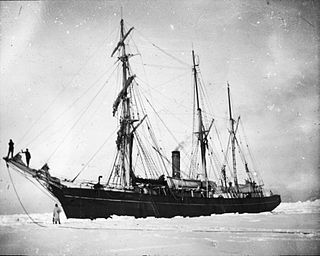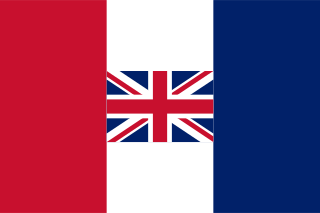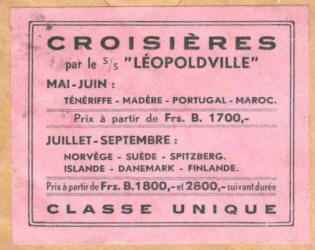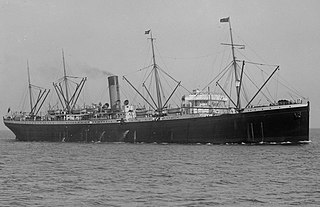
SS Yongala was a passenger steamship that was built in England in 1903 for the Adelaide Steamship Company. She sank in a cyclone off the coast of Queensland in 1911, with the loss of all 122 passengers and crew aboard.

Nimrod was a wooden-hulled, three-masted sailing ship with auxiliary steam engine that was built in Scotland in 1867 as a whaler. She was the ship with which Ernest Shackleton made his Nimrod Expedition to Antarctica in 1908–09. After the expedition she returned to commercial service, and in 1919 she was wrecked in the North Sea with the loss of ten members of her crew.

Maori was a British refrigerated cargo steamship built in 1893 by C.S. Swan & Hunter of Wallsend-on-Tyne for Shaw, Saville & Albion Co. of London with intention of transporting frozen meat and produce from Australia and New Zealand to the United Kingdom. The vessel stayed on this trade route through her entire career. In August 1909 while on one of her regular trips, she was wrecked on the coast of South Africa with the loss of thirty two of her crew.

P Henderson & Company, also known as Paddy Henderson, was a ship owning and management company based in Glasgow, Scotland and operating to Burma. Patrick Henderson started business in Glasgow as a merchant at the age of 25 in 1834. He had three brothers. Two were merchants working for an agent in the Italian port of Leghorn; the third, George, was a sea captain with his own ship.

SS Léopoldville was a 11,509 GRT passenger liner of the Compagnie Belge Maritime du Congo. She was converted for use as a troopship in the Second World War, and on December 24, 1944, while sailing between Southampton and Cherbourg, was torpedoed and sunk by the German submarine U-486. As a result, about 763 US soldiers and 56 of the ship's crew died.
SS Castilian was a British cargo steamship and is now a dangerous wreck in the Irish Sea off the coast of North Wales. She was built in 1919 to a standard First World War design. In 1943 while carrying munitions she struck rocks off The Skerries, Isle of Anglesey and sank.

SS Suevic was a steamship built by Harland and Wolff in Belfast for the White Star Line. Suevic was the fifth and last of the Jubilee-class ocean liners, built specifically to service the Liverpool-Cape Town-Sydney route, along with her sister ship Runic. In 1907 she was wrecked off the south coast of England, but in the largest rescue of its kind, all passengers and crew were saved. The ship herself was deliberately broken in two, and a new bow was attached to the salvaged stern portion. Later serving as a Norwegian whaling factory ship carrying the name Skytteren, she was scuttled off the Swedish coast in 1942 to prevent her capture by ships of Nazi Germany.

The Compagnie Maritime Belge (CMB) is one of the oldest Antwerp ship-owners. It is controlled by the Saverys family who also own major stakes in the Exmar and Euronav groups.
SS Montrose was a British merchant steamship that was built in 1897 and wrecked in 1914. She was built as a cargo liner for Elder, Dempster & Company. In 1903 the Canadian Pacific Railway bought her and had her converted into a passenger liner.
Persier was a 5,382 GRT cargo ship which was built in 1918 as War Buffalo for the British Shipping Controller. In 1919, she was sold to Belgium and renamed Persier. Between 1934 and 1941 she also held a passenger certificate. She was driven ashore on the Icelandic coast in a storm in February 1941 which put her out of action for two years. Returned to service in February 1943, she served until 11 February 1945, when she was torpedoed and sunk by U-1017 with the loss of 20 crew.
SS Norwich City was a British cargo steamship. She was built in 1911 as Normanby, and renamed Norwich City in 1919. She was wrecked in the Pacific Ocean in 1929. For many years her wreck was a sea mark on the atoll of Nikumaroro. The wreck is now largely broken up.
SS Empire Chamois was a 5,864 GRT cargo ship which was built in 1918 by Ames Shipbuilding and Drydock Co, Seattle. She was ordered by the Compagnie Générale Transatlantique but was requisitioned by the United States Navy and commissioned as USS West Mount with the pennant number ID-3202 in 1918. She was decommissioned in May 1919 and passed to the United States Shipping Board (USSB) as SS Westmount. In 1927 she was sold to the Dimon Steamship Corporation and renamed SS Pacific Redwood. She returned to the USSB in 1932 and passed to the United States Maritime Commission (USMC) in 1937. In 1940, she was passed to the Ministry of Shipping, passing to the Ministry of War Transport in 1941 and being renamed SS Empire Chamois. She was sold to Astral Shipping Co Ltd in 1946 and renamed SS Granview. In 1949 she was sold to the Compagnia Maritime del Este, Panama and renamed SS Chamois, serving until 1958 when she was scrapped. She was the last Ames-built ship afloat.

SS Polar Chief was a merchant steamship that was built in England in 1897 and scrapped in Scotland in 1952. In her 55-year career she had previously been called Montcalm, RFA Crenella, Crenella, Rey Alfonso, Anglo-Norse and Empire Chief. Early in the First World War she spent eight months pretending to be the battleship HMS Audacious.
SS Burgondier was a 5,297-ton cargo steamship built to a First World War standard design by Caird & Company at Greenock on the Firth of Clyde. She changed owners and names several times, becoming the Azul, David Dawson, Penteli and finally Brockley Hill. She was sunk by enemy action in 1941.
A number of steamships have been named Leopoldville or Léopoldville:
SS Bury Hill was a cargo ship built in England during the First World War as Cardigan, later becoming Pensylvanie of Compagnie Générale Transatlantique (CGT). In 1934 she returned to the British register as Bury Hill but was wrecked on the coast of Senegal in 1936.
SS Lambridge was a 5,119 GRT UK cargo ship that was built in 1917, gave 28 years of service and was scuttled in 1945. She was launched as Glennevis but changed owners and names a number of times, successively becoming African Prince, Pentridge Hill, Botlea, HMS Lambridge and Lambridge. She was scuttled as part of a programme to dispose of UK stocks of chemical weapons.

SS Rio Tercero was a cargo steamship that was launched in England in 1912 as Eboe. She was renamed Fortunstella in 1938, and Rio Tercero in 1941. A U-boat sank her in the Battle of the Atlantic in 1942.

SS Frankenwald was a passenger and cargo steamship that was launched in England in 1908 for Hamburg America Line. In 1919 France seized her as part of Germany's World War I reparations. In 1920 the Compagnie de Navigation Paquet bought her and renamed her Tadla. A Turkish shipowner bought her in 1934 and renamed her Tari. She passed through a succession of Turkish owners, and was scrapped in 1967.

SS Falaba was a British cargo liner. She was built in Scotland in 1906 and sunk by a U-boat in the North Atlantic in 1915. The sinking killed more than 100 people, provoking outrage in both the United Kingdom and United States.













